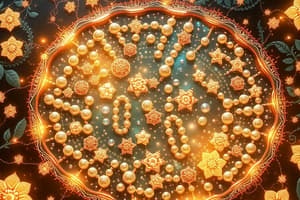Podcast
Questions and Answers
What does the cell membrane primarily act as?
What does the cell membrane primarily act as?
- A selective barrier controlling movement (correct)
- A rigid structure providing support
- A nutrient reservoir for cell growth
- An energy source for the cell
Which component of the cell membrane is responsible for allowing specific molecules to pass through?
Which component of the cell membrane is responsible for allowing specific molecules to pass through?
- Cholesterol
- Phospholipid bilayer
- Carbohydrate chains
- Embedded proteins (correct)
What structural feature of the phospholipid is polar?
What structural feature of the phospholipid is polar?
- The cholesterol content
- The embedded proteins
- The lipid tails
- The phosphate-containing head (correct)
In what way do cholesterol and phytosterols function within the cell membrane?
In what way do cholesterol and phytosterols function within the cell membrane?
What is the primary function of carbohydrate chains in the cell membrane?
What is the primary function of carbohydrate chains in the cell membrane?
How does the phospholipid bilayer form in relation to water?
How does the phospholipid bilayer form in relation to water?
What role do peripheral proteins play in the cell membrane?
What role do peripheral proteins play in the cell membrane?
What is the primary characteristic of the Fluid Mosaic Model of the cell membrane?
What is the primary characteristic of the Fluid Mosaic Model of the cell membrane?
What is the primary role of glycoproteins in the cell membrane?
What is the primary role of glycoproteins in the cell membrane?
Which of the following best describes integral proteins?
Which of the following best describes integral proteins?
How do carrier proteins facilitate transport across the cell membrane?
How do carrier proteins facilitate transport across the cell membrane?
Which type of transport does not require energy expenditure?
Which type of transport does not require energy expenditure?
What characterizes osmosis in a cellular context?
What characterizes osmosis in a cellular context?
In which of the following solutions will a cell remain unchanged in size?
In which of the following solutions will a cell remain unchanged in size?
What role do glycolipids play in the cell membrane?
What role do glycolipids play in the cell membrane?
Which statement accurately describes passive transport?
Which statement accurately describes passive transport?
What is the effect of cholesterol on animal cell membranes?
What is the effect of cholesterol on animal cell membranes?
What distinguishes peripheral proteins from integral proteins?
What distinguishes peripheral proteins from integral proteins?
Flashcards are hidden until you start studying
Study Notes
Cell Membrane Overview
- All living cells possess a plasma membrane that encloses cellular content, maintains shape, and acts as a selective barrier for transport.
- The membrane enables cellular connection and communication.
- It is semi-permeable, allowing specific substances to pass while blocking others.
Fluid Mosaic Model
- The cell membrane has a mosaic structure composed of proteins, phospholipids, and carbohydrates.
- The model illustrates fluidity, as proteins and lipids can move within the membrane.
- Cholesterol and phytosterols contribute to membrane stability and flexibility.
Phospholipid Bilayer
- Comprised of phosphate-containing heads (polar) and two lipid tails (nonpolar).
- Arranges in a bilayer with hydrophilic heads facing water and hydrophobic tails shielded from water, crucial for cell function.
Membrane Components and Their Functions
- Phospholipids: Form the basic structure of the membrane bilayer.
- Embedded Proteins: Act as gateways for larger molecules that cannot pass via diffusion or osmosis.
- Peripheral Proteins: Participate in signaling rather than forming direct structural components.
- Cholesterol: Stabilizes membrane fluidity; adjusts membrane behavior in varying temperatures.
- Carbohydrate Chains: Facilitate cell recognition and provide protection.
- Glycoproteins and Glycolipids: Enable cell-cell recognition and adhesion; play roles in stability and signaling.
Role of the Cytoskeleton
- Provides structure, organization, and resilience against stress; facilitates movement and shape changes.
Lipid Functionality
- Cholesterol enhances membrane flexibility in animals; phytosterols perform a similar role in plants.
- Lipids also support membrane repair and growth.
Protein Functionality
- Integral Proteins: Permanently embedded, involved in both passive and active transport.
- Transmembrane Proteins: Span the bilayer, facilitating exchanges across the membrane.
- Peripheral Proteins: Temporarily attach to either the surface or other integral proteins.
Carbohydrate Functionality
- Often linked to proteins (glycoproteins) or lipids (glycolipids) on the outer membrane surface.
- Essential for cell recognition and adherence, influencing immune response and hormone interactions.
Types of Proteins
- Channel Proteins: Form hydrophilic channels for specific substances to passively diffuse.
- Carrier Proteins: Bind with ions or molecules and facilitate their transport across the membrane.
Cell Transport Mechanisms
- Cells require proteins, water, nutrients, ions, and gases to function effectively.
Passive Transport
- Involves the movement of materials across the membrane without energy input.
- Diffusion: Movement from high to low concentration, relying on concentration gradients.
- Facilitated Diffusion: Utilizes channel and carrier proteins for larger molecules.
- Channel Proteins: Provide tunnels for specific molecules.
- Carrier Proteins: Change shape to transport materials across the membrane.
- Simple Diffusion: Direct movement of substances through the phospholipid bilayer.
- Osmosis: Movement of water from high to low concentration through a semipermeable membrane.
Solution Characteristics
- Isotonic Solutions: Equal solute concentrations; water movement into and out of the cell is balanced.
- Hypertonic Solutions: Higher solute concentration outside the cell leads to water exiting the cell.
Studying That Suits You
Use AI to generate personalized quizzes and flashcards to suit your learning preferences.



